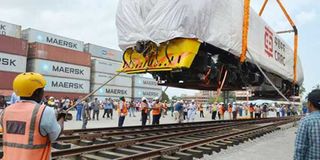Faster SGR trains poised to overhaul transport industry

Port workers offload the first batch of standard gauge railway cargo locomotives at the port of Mombasa. The passenger trains expected next month can take 52 buses off the Nairobi-Mombasa route as each can ferry 1,096 people on a single trip. PHOTO | KEVIN ODIT | NATION MEDIA GROUP
What you need to know:
- The entire journey is projected to take slightly over four hours.
- Uganda has since announced that construction of the 273km Malaba-Kampala SGR link will take 40 months.
The arrival of high-speed and high-capacity passenger locomotives next month is expected to drastically change Kenya’s railway history.
It will be a journey that began with the steam-powered Lunatic Express at the dawn of the last century.
Aboard will be free Wi-Fi, social amenities and catering facilities, among other comforts.
The initial five passenger locomotives will have higher speeds than the recently docked freight engines — at a recommended 120kph to a maximum 158kph.
The cargo trains will run at a recommended 80kph, but can accelerate to 120kph.
The passenger locomotives have a capacity to haul 1,096 travellers on a single trip. They will ply the 472km Nairobi-Mombasa route, making stopovers at 40 newly built stations.
The entire journey is projected to take slightly over four hours.
BUSINESS ON THE GO
Kenya Railways chief executive Atanas Maina told the Sunday Nation that the modern 6,000-litre diesel-powered locomotives will enable travellers to conduct business on the go.
He said the contractor, China Road and Bridge Construction Company, was putting finishing touches to aspects such as slope protection, drainage system adjustments and fencing off of newly built stations.
Mr Maina said that signalling, communication and electric works had been completed, with the line testing exercise expected to commence in March in preparation for the official launch on June 1, 2017.
“These passenger locomotives will usher Kenya into a new era. They are the backbone of our future long-distance transport system, linking up more towns, cities and countries,” he said.
Mr Maina added that the 40 coaches with varying passenger capacities will be segmented into economy class (118 passengers) and luxury first-class (72 sleep-in passengers with access to in-built television).
NOISELESS
“It will be noiseless and fast. Its optimised aerodynamic design will help reduce fuel consumption substantially,” he said.
This is unlike the traditional nightlong train that was slow and needed frequent supply of dry firewood and water to power the steam engine. That was before the slightly faster diesel engines made their debut.
Mr Maina said that the second phase, comprising the 120km Nairobi-Naivasha section, had been launched.
It will proceed to Narok and then to the border town of Malaba, where it will join the soon-to-be-built Kampala-Malaba railway.
“The Kenya-Uganda and eventually Kigali (Rwanda) link will help East Africans enjoy borderless and seamless travel on locomotives with powerful engines and traction to tackle the terrain,” he said.
DECONGESTING HIGHWAY
Uganda has announced that construction of the 273km Malaba-Kampala SGR link will take 40 months at the cost of about Sh230 billion.
China Harbour Engineering Company has been contracted to implement the project, financed jointly by the Uganda government and China’s Export-Import Bank.
The projected 43 cargo locomotives on Kenya's SGR will each have the capacity to haul 108 twenty-foot-long containers (equivalent to 108 trucks) on every eight-hour trip, instead of the three-day trip by trucks from Mombasa to Nairobi.
This will translate to about 4,644 trucks off the road when all the 43 locomotive run full steam.
A single passenger train trip will take 52 buses off the Nairobi-Mombasa route as each locomotive can ferry 1,096 travellers.
CUTTING TRANSPORT COSTS
The development has seen some bus companies plying the route upping their game by improving services offered to clients to include snacks, water dispensers, inbuilt toilets individual entertainment units and adjustable seats.
The rail project is part of Vision 2030 programmes, mooted by the government of previous president Mwai Kibaki. It is expected to jump-start the economy by reducing the cost of travel that has been a major bane to the industry, making local goods uncompetitive globally.
The locomotives and the rolling stock are being manufactured by CRRC Qishuyan Corporation Limited in China.
There are about 25,000 full-time workers on the SGR, with an extra 5,000 people indirectly linked to companies supplying materials to the project.
New economic centres are expected to spring up along the way, further spreading development to Mombasa, Kilifi, Kwale, Taita-Taveta, Makueni, Kajiado, Machakos and Nairobi counties.





